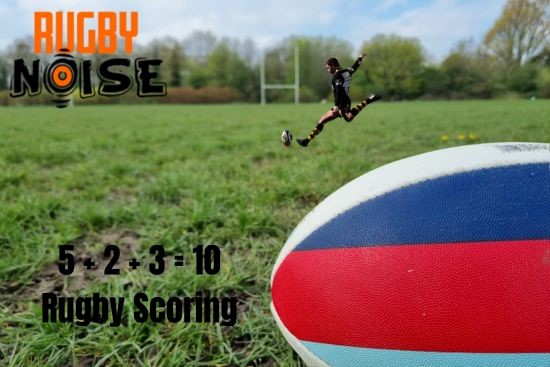For fans who might be new to rugby, it can take some time to figure out exactly how the scoring works. So let’s take a look at how scoring works in rugby.
How does rugby scoring work? In rugby, a try is worth five points, while a successfully kicked penalty or drop goal is worth three points. A successful conversion kick after a try is worth two points, a conversion attempt only takes place after a try is scored.

The main goal in rugby is to score a try. A try Is scored when a player grounds the ball by applying downward pressure on it over the opponents try line. If a team can do this legally then it is worth five points. As it is the highest value method to score points, it is the main goal of every team who play rugby.
As well as scoring a try, there are also other ways in which you can score points in rugby. After a try is scored, the team who scores it can then attempt a conversion. This is a set kick which takes place in line with where the try was scored. If this kick is successful, it is worth two points.
This is not the only way that players can score points in rugby with their feet. Penalties are one of the most common ways that points are scored in rugby. When one team wins a penalty, they have the option to attempt to kick the ball through the posts from the spot where they won the penalty.
If this kick is successful, then it is worth three points. Teams will take penalties as a safer way to build up the score, rather than try the risky option which is to target scoring tries.
The other slightly less common way that rugby players score points with their feet is through a drop goal. This occurs in open play. Any player can drop the ball onto the floor and if they immediately kick the ball and it goes through the posts then it is also worth three points.
These are the only ways in which you can score points in rugby. At the end of the game, the team with the most points wins the game. Teams are not purely focused on the win when it comes to scoring points in rugby.
The bonus point system in the sport means that there are other incentives for teams. The try scoring bonus point means that if any team scores four tries, they get a bonus point for the league or competition that they are in. Major competitions like the Rugby World Cup, Six Nations and URC use this format.
There is a similar bonus point format that states that if the winning team scores three or more tries than their opponent, then they get an extra bonus point. This system is most famously used in the Top 14 which is the first tier of French rugby.
This system gives incentives for both teams to score more tries, as it makes the game more exciting for spectators to watch. There is also a losing bonus point system. This states that if a team loses by seven or fewer points, then they will receive a losing bonus point in their league or competition.
The losing bonus point system encourages losing teams to still fight to the end, even if they are more than one score away from the winning team.
How do you score seven points in rugby?
During a rugby game you might notice that the score is very often in multiples of seven. Well that is down to how teams score points in rugby.
The most common way to score seven points in rugby is by scoring a try and then kicking the conversion. This gives the team seven points and as it is the most common way that points are scored in rugby, you can see why the score is usually a multiple of seven. But there is another way in which you can score seven points without kicking a conversion.
A penalty try is how you score seven points in rugby. When a penalty try is awarded, the team does not need to attempt the conversion because it is automatically given to them. This means that no matter where across the try line a penalty try is awarded, the conversion will always be automatic.
This was part of the format of a penalty try to incentivise the defending team being on their best behaviour near the try line and not concede a penalty try. If the conversion still had to be taken, then it is likely you would see more penalty tries being given.
How do Rugby points work in the league?
Rugby has many different competitions that work in a league format. But if you take a look at the table, you might notice that the points are different to that in football.
In rugby, you get four points for a win, two points for a draw and zero points for a loss. The emphasis on winning the game is highlighted by the fact that a win is worth four points, while a draw is worth half as much as a win. This is likely because it is rare for games to end as a draw in rugby.
While the losing team does usually get zero points added to their league tally at the end of a game, they do have a couple of opportunities for bonus points. The losing bonus point system means that if one team loses a game by seven or fewer points then they get a losing bonus point.
This system is used by major competitions like the Rugby World Cup and Six Nations. There is also a try scoring bonus system. This states that if a team scores four tries in a single game then they get a bonus point.
Most major competitions use this system, but there is a slight adjustment. Sometimes the bonus point goes to the winning team if they score three or more tries than their opponent.
